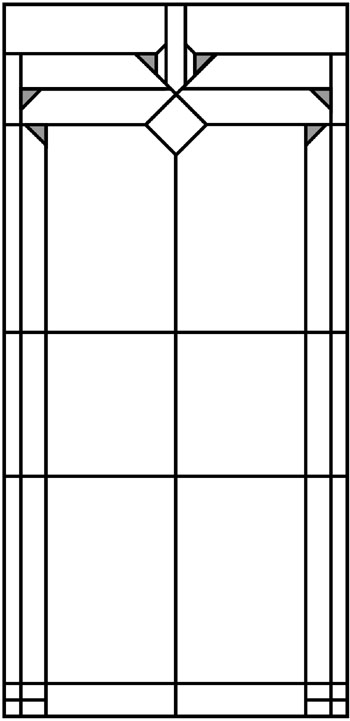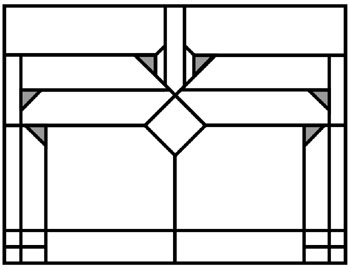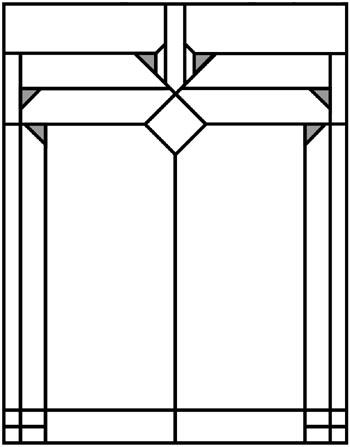|
|
|
Samuel & Lena Horner Residence, Chicago (1908 - S.142) |
|
|
|
Introduction Floor Plan
1908 Floor Plan 1911
Horner Residence (Circa 1910)
Horner Residence (Circa 1915-20) |
|
Gilman Lane c1935-1945
Art Glass Doors and Windows
Property Today
BIBLIOGRAPHY
ADDITIONAL WRIGHT sTUDIES |
|
|
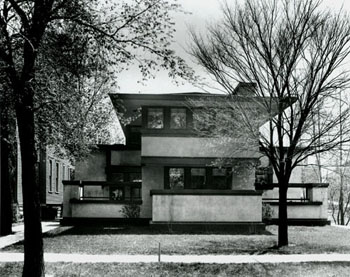 |
Date: Circa
1910 Description:
Samuel & Lena Horner Residence (1908 - S.142). Front exterior
viewed from the street, looking South circa 1910. As you entered
the sidewalk on the left, you passed the Garden Wall with it's
pedestal that begged for a urn. A large prairie styled Robie
House urn would have fit perfectly. Turning right into the
Garden, you entered the home through the art glass front door.
The Reception Room is on the left. Five wide stairs lead up to
the balance of the first level. The Living Room is in the center
foreground with art glass doors that exit out to an enclosed
Terrace. The Stairway landing and Kitchen overlooked the
symmetrical Garden and Garden Wall on the right. Upper level. As
you reached the top of the stairs, the Bedrooms and the Bath
were reached by turning left. The Balcony on the east (left) was
reached through the two smaller Bedrooms in the center of the
upper level. A row of art glass windows were just beneath the
roof line of the Master Bedroom in the center. Turning right at
the top of the stairs lead to the exterior balcony over the
Kitchen. Both Balconies had built-in Planters on either end. The
low pitch of the roof almost gives the appearance of being flat
like the Gale Residence. Most likely photographed by Henry
Fuermann.
Size:
Original 10 x 8 B&W photograph.
S#: 0094.24.0612 |
|
|
|
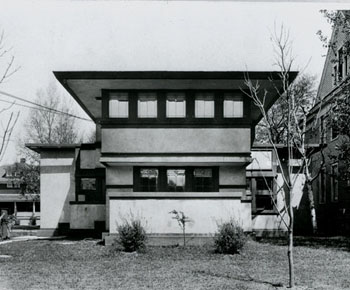 |
Date: Circa
1910 Description:
Samuel & Lena Horner Residence (1908 - S.142). Back exterior
viewed from the back yard, looking North circa 1910. The Kitchen
and back Entrance is on the left. The Dining Room is in the
center foreground with art glass doors that exit out to the
Terrace. On the right side stairs lead down to the back yard.
From the Living and Dining Room, five wide stairs lead down to
the Reception Room on the right. Note: the house across the
street seen on the left still exists. Upper level. A door at the
top of the stairs leads out to the Balcony over the Kitchen on
the left. Bedrooms and the Bath are in the center, The Balcony
over the Kitchen on the east (right) was reached through the two
smaller Bedrooms in the center of the upper level. A row of art
glass windows were just beneath the roof line of the large
Bedroom in the center. Both Balconies had built-in Planters on
either end. The low pitch of the roof almost gives the
appearance of being flat like the Gale Residence. Most likely
photographed by Henry Fuermann.
Size:
Original 9.7 x 8 B&W photograph.
S#: 0094.25.0612 |
|
|
|
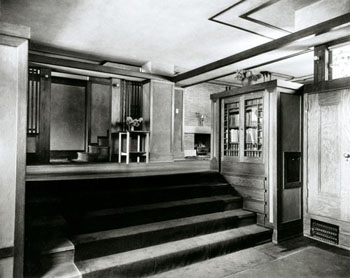 |
Date: Circa
1910 Description:
Samuel & Lena Horner Residence (1908 - S.142). View of the
Living Room from the Reception Room circa 1910. As you opened
the art glass front door, you entered the Reception Room. Wright
chose wood and stucco for the exterior of the home. Behind the
camera to the left were built-in seats. Above the coat closet
and front door to the right, were a pair of clerestory art glass
windows. On either side of the five wide stairs were built-in
oak book cases, which opened up in the front and back. At the
top of the stairs the Dining Room was to the left. Entering the
hall straight ahead, enclosed by a pair of vertical spindled
screens, you could turn left to go to the Kitchen, or take the
stairs to the right to reach the second level. The Living Room
on the right. The large, prairie styled Fireplace was located in
the Living Room to the right, covered most of the west wall.
Photographed by Henry Fuermann.
Size:
Original 10 x 8 B&W photograph.
S#: 0094.26.0612 |
|
|
|
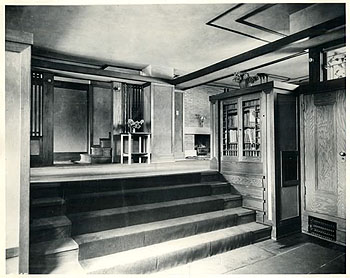 |
Date: Circa 1910
Title:
Samuel & Lena Horner Residence circa 1910 (1908 - S.142).
Description:
View of the Living Room from the Reception Room circa 1910. As
you opened the art glass front door, you entered the Reception
Room. Wright chose wood and stucco for the exterior of the home.
Behind the camera to the left were built-in seats. Above the
coat closet and front door to the right, were a pair of
clerestory art glass windows. On either side of the five wide
stairs were built-in oak book cases, which opened up in the
front and back. At the top of the stairs the Dining Room was to
the left. Entering the hall straight ahead, enclosed by a pair
of vertical spindled screens, you could turn left to go to the
Kitchen, or take the stairs to the right to reach the second
level. The Living Room on the right. The large, prairie styled
Fireplace was located in the Living Room to the right, covered
most of the west wall. Clipping pasted to verso: "One of the
early tri-levels, Wright’s Horner house was built in 1908.
Indirect lighting is beamed out from cornices near ceiling. This
house also bears another Wright imprint, the free-flowing rooms
not blocked off by solid partitions." Stamped on clipping: "Mar
27 1957." Photographed by Henry Fuermann.
Size:
10 x 8 B&W photograph.
S#: 0094.42.0115 |
|
|
|
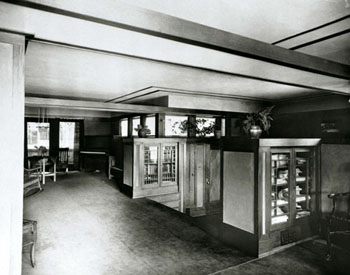 |
Date: Circa
1910 Description:
Samuel & Lena Horner Residence (1908 - S.142). View of the
Living Room from the Dining Room circa 1910. Art glass doors in
the Living Room on the left, opened out to an enclosed Terrace.
The west (left) wall of the Living Room was covered by the
fireplace. The east (right) wall of the Living Room included
three "high windows" that fell in line with the two in the
Reception Room. On either side of the wide stairs were built-in
oak book cases, which opened up in the front and back.
Photographed by Henry Fuermann.
Size:
Original 10 x 8 B&W photograph.
S#: 0094.27.0612 |
|
|
|
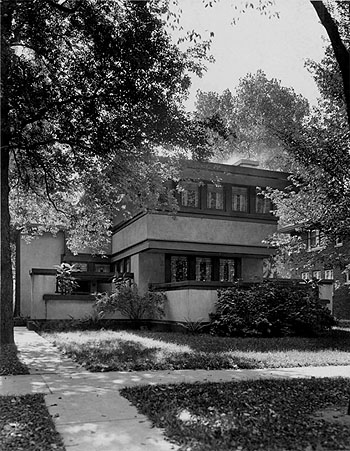 |
Date:
Circa 1915-1920 Description:
Samuel & Lena Horner Residence (1908 - S.142). Front exterior
viewed from the street, looking South circa 1915-1920. As you
entered the sidewalk on the left, you passed the Garden Wall
with it's pedestal that begged for a urn. A large prairie styled
Robie House urn would have fit perfectly. Turning right into the
Garden, you entered the home through the front door. The
Reception Room is on the left. Five wide stairs lead up to the
balance of the first level. The Living Room is in the center
foreground with art glass doors that exit out to an enclosed
Terrace. The symmetrical Garden Wall on the far right. Upper
level. As you reached the top of the stairs, the Bedrooms and
the Bath were reached by turning left. The Balcony on the east
(left) above the Reception Room was reached through the two
smaller Bedrooms in the center of the upper level. A row of art
glass windows were just beneath the roof line of the Master
Bedroom in the center. The Balconies had built-in Planters on
either end. The low pitch of the roof almost gives the
appearance of being flat like the Gale Residence. Photographed
by Henry Fuermann. Courtesy of The Art Institute of Chicago.
Size:
Original 7 x 9 B&W photograph.
S#: 0128.11.0612 |
|
|
|
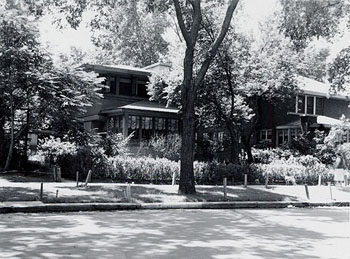 |
Date: Circa
1935-1940 Description:
Samuel & Lena Horner Residence (1908 - S.142). Front exterior viewed
from the street, looking Southwest circa 1935-1940. As you entered
the sidewalk on the left side of the home, you passed the Garden
Wall. Turning right into the Garden, you entered the home through
the front door into the Reception Room on the left. Five wide stairs
lead up to the balance of the first level. The Living Room Terrace
in the center foreground was enclosed with a roof and windows. Upper
level. As you reached the top of the stairs, the Bedrooms and the
Bath were reached by turning left. A row of art glass windows were
just beneath the roof line of the Master Bedroom in the center. Both
Balconies had built-in Planters on either end. The low pitch of the
roof almost gives the appearance of being flat like the Gale
Residence. Photographed by Gilman Lane. Courtesy of the Oak Park
Public Library.
Size:
Original 8 x 6 B&W photograph.
S#: 0397.15.0612 |
|
|
|
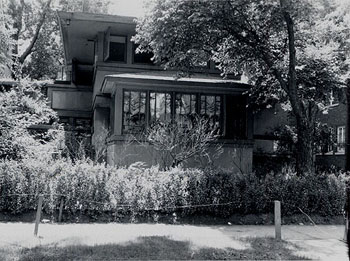 |
Date: Circa
1935-1940 Description:
Samuel & Lena Horner Residence (1908 - S.142). Front exterior
viewed from the street, looking South circa 1935-1940. As you
entered the sidewalk on the left side of the home, you passed
the Garden Wall. Turning right into the Garden, you entered the
home through the front door into the Reception Room on the left.
Five wide stairs lead up to the balance of the first level. The
Living Room Terrace in the center foreground was enclosed with a
roof and windows. The Stairway landing and Kitchen overlooked
the symmetrical Garden and Garden Wall on the right. Upper
level. As you reached the top of the stairs, the Bedrooms and
the Bath were reached by turning left. The Balcony on the east
(left) was reached through the two smaller Bedrooms in the
center of the upper level. A row of art glass windows were just
beneath the roof line of the Master Bedroom in the center.
Turning right at the top of the stairs lead to the exterior
balcony over the Kitchen. Both Balconies had built-in Planters
on either end. The low pitch of the roof almost gives the
appearance of being flat like the Gale Residence. Photographed
by Gilman Lane. Courtesy of the Oak Park Public Library.
Size:
Original 8 x 6 B&W photograph.
S#: 0397.16.0612 |
|
|
|
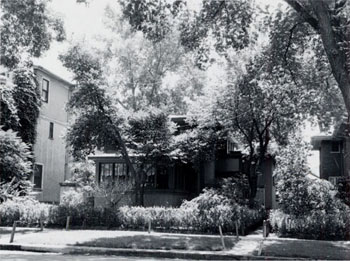 |
Date: Circa
1935-1940 Description:
Samuel & Lena Horner Residence (1908 - S.142). Front exterior
viewed from the street, looking Southeast circa 1935-1940. As
you entered the sidewalk on the left side of the home, you
passed the Garden Wall. Turning right into the Garden, you
entered the home through the front door into the Reception Room
on the left. Five wide stairs lead up to the balance of the
first level. The Living Room Terrace in the center foreground
was enclosed with a roof and windows. The Stairway landing and
Kitchen overlooked the symmetrical Garden and Garden Wall on the
right. Upper level. As you reached the top of the stairs, the
Bedrooms and the Bath were reached by turning left. A row of art
glass windows were just beneath the roof line of the Master
Bedroom in the center. Turning right at the top of the stairs
lead to the exterior balcony over the Kitchen. Both Balconies
had built-in Planters on either end. The low pitch of the roof
almost gives the appearance of being flat like the Gale
Residence. Photographed by Gilman Lane. Courtesy of the Oak Park
Public Library.
Size:
Original 8 x 6 B&W photograph.
S#: 0397.17.0612 |
|
|
|
|
|
|
|
|
|
Introduction |
|
|
|
|
The Horner Residence
was a smaller Prairie styled home designed at the height of Wright's
Prairie period. The cruciform floor plan is similar in
footprint to the J. J. Walser (1903 - S.091), the George Barton
Residence (1903 - S.103), and the K. C. DeRhodes Residence
(1906 - S.125), but with modifications. A
major difference was the grade of the first level. Like the
DeRhodes, only the
Entry / Reception Room was at ground level. The balance of
the first level was five steps higher. This allowed
utilities to be housed in the "basement" which was accessed
by stairs next to the kitchen.
At a glance the Horner Residence might be mistaken for the
Thomas Gale (1904 - S.098) Residence. With it low pitched
roof, it nearly appears flat, until seen at a distance.
When Wright published "Ausgeführte
Bauten und Entwürfe von Frank Lloyd Wright" in
1910, he
chose not to include the Horner Residence, but instead
included an illustration and floor plan of the Barton (Plate
XXVI), DeRhodes (Plate XXIX), and although not the same
floor plan, the Gale (Plate XLV).
One year later Wright did included an
exterior and interior photograph of the Horner Residence, and the floor plan for the
first and second level in "Frank
Lloyd Wright, Ausgeführte Bauten"
(Executed Buildings),
1911 pages 62-63. That same year Wright included the same
two photographs and floor plan when he published
"Frank
Lloyd Wright,
Chicago" (Sonderheft),
1911, pages 53-54.
The Horner Residence is a smaller version
of Wright's Prairie styled home but included many of the
prairie styled features found in most of Wright's designed
during that period. Broad overhangs, balconies, terraces, built-in
planters, cabinets, furniture and seating, rich oak trim, distinct
horizontal; and vertical lines, Wright designed art glass
windows and light fixtures, large centrally located
fireplace, vertical spindled screens enclosing the stairway.
Wright chose wood and stucco for the exterior of the home.
Samuel H. Horner was born on October 19,
1857 in Morrison, Illinois. He began his career as a "piano
man", selling pianos in his home town. Lena J. Kent was born
on October 22, 1864. Records indicate that Samuel and Lena
were married in Whiteside County, Illinois, which included
the town of Morrison.
They moved to the big city, Chicago, where
he became a piano salesman at Steger & Sons, Co. In
1893, at the age of 36 he took the plunge and started his
own company, The Horner Piano Co. It was located at 549 West
North Avenue. This was centrally located to some of Wright's
clients at the time. This begs the question. With Wright's
love of the piano, was this the connection that brought
Frank Lloyd Wright and Samuel Horner together. John Lloyd
Wright wrote, "It seemed to me in those days that he would
rather have had six grand pianos and hold off the sheriff,
than one fully paid without the sheriff."
"My Father",
page 77.
In 1910, Samuel, Lena and A. Horner, Samuel's nephew.
incorporated the Horner Piano Co. with a capital stock of
$20,000, for the manufacture and sale of musical instruments
and pianos. That is the equivalent of over $465,000 in 2010
dollars. At the time he was quoted that "for the present he
would confine his attention to selling, but admitted that he
may enter the manufacturing business a little later on".
There is no evidence that they entered the manufacturing
business.
In October 1912, they announced the
marriage of their |
|
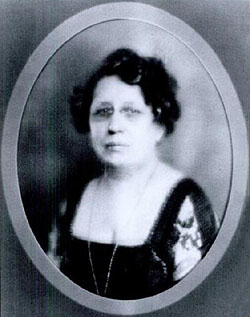 |
|
Mrs. Lena J. Horner. Courtesy of the Rogers Park
Historical Society. |
daughter Hazel Beatrice Horner to Charles
O. Hilton, who were married in their Wright designed home.
"The house was decorated in autumn foliage and red and
white roses."
Lena was very active in the Rogers Park
Women's Club as early as 1914. In 1917 she became president
and served until 1919. "Lena K. Horner... was part of a
fashion revolution with her daring décolletage on full
display; a daring dress with a mesh overlay. Her relaxed
look would pave the way for the short hemlines and drop
waists of the 1920s..."
During February, 1918 Samuel Horner became
seriously ill, and was confirmed to his home for two months.
During his illness, his son, Sam Hornton Jr. was in charge
of the business. After recovering, it was
announced in June of 1918 that he purchased his nephew's
interest in the Horner Piano Company. His recover was not
sustained, and on July 11, 1918, at the age of sixty,
he passed away at his Wright designed home. He was buried in his home town
of Morrison, Illinois. His obituary in The Music Trade
Review reported, "Mr. Horner was one of the best known of
the old-time piano men in Chicago."
Horner's son-in-law Charles O. Hilton was
promoted to vice-president and manager of the Horner Piano
Co., but resigned in 1920 to take another position moving
his family to Seattle then Baltimore.
Lena continued to live in her Wright
designed home for another seven years after her husbands
death. But as the city expanded north, single family homes
were replaced with apartments. Such was the case with Rogers
Park. In June, 1925 she moved the Horner Piano Co. and her
home ten miles north to Evanston, Illinois. She would
continue to carry "pianos, player-pianos, reproducers and
musical merchandise as well as radio equipment".
Music Trade Review reported that Mrs.
Samuel Horner, president of the Horner Piano Co., died on
January 25, 1928 after a brief illness. Funeral services
were held at her home in Evanston.
But by the time Gilman Lane photographed the
home circa 1940, the adjacent home to the East had already
been replaced by a large apartment complex. The front porch
had also been enclosed. The city continued to grow, and just
44 years after Wright designed the home, it too was consumed
by growth. Combined with a lack of appreciation for Wright's work,
it was demolished to make room for a small
non-descript apartment building.
June 2012 |
|
|
|
|
|
|
|
|
Original Floor Plan 1908 |
|
|
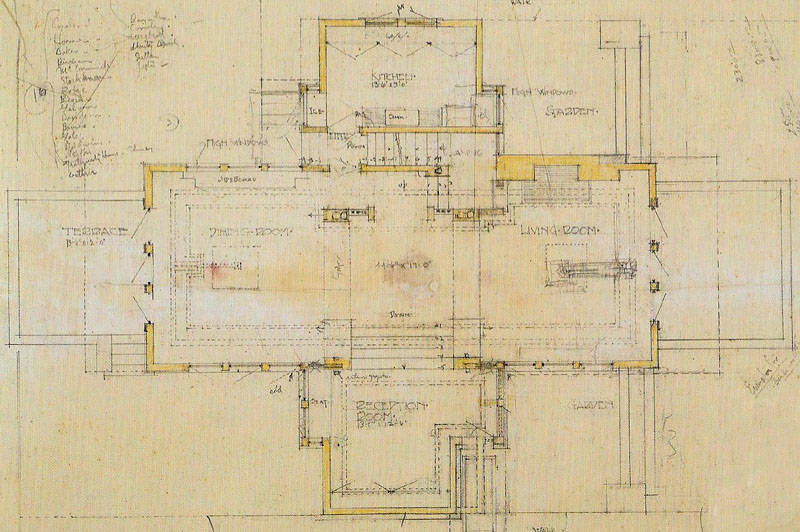 |
|
Original floor plan for the First
level, 1908. As you walk through the front door
you enter the Reception Room. The front door faced East in
this original drawing, but faced the street (North) when the
home was constructed. Built-in oak cabinets and seating
lined the walls. Stairs lead up to the balance of the first
level. Built-in book cases are on either side of the stairs.
The Dining Room is on the left, the Living Room is on the
right. A Sideboard is built-into the west wall of the Dining
Room, high art glass windows above it. The large, prairie
styled Fireplace is located in the Living Room, covering
most of the west wall. Art glass doors lead out to a
Terraces on either end. Vertical spindled screens enclose the
stairway that leads to the second level and a doorway that
leads to the Kitchen. Courtesy of
"Frank
Lloyd Wright Foundation. |
| |
|
|
|
|
|
|
|
Floor Plan 1911 |
|
|
|
|
|
One year after Frank Lloyd
Wright published his seminal "Ausgeführte
Bauten und Entwürfe von Frank Lloyd Wright"
(S.87), he wrote and produced "Frank
Lloyd Wright, Ausgeführte Bauten"
(Executed Buildings). All in German, it was published by |
|
Ernst Wasmuth A.-G., Berlin in
1911. Wright included the floor plan of the Horner Residence
for the first and second floors (page 63).
That same year Wright included the same floor plan when he
published "Frank
Lloyd Wright, Chicago"
(Sonderheft), 1911, pages 53. |
|
|
|
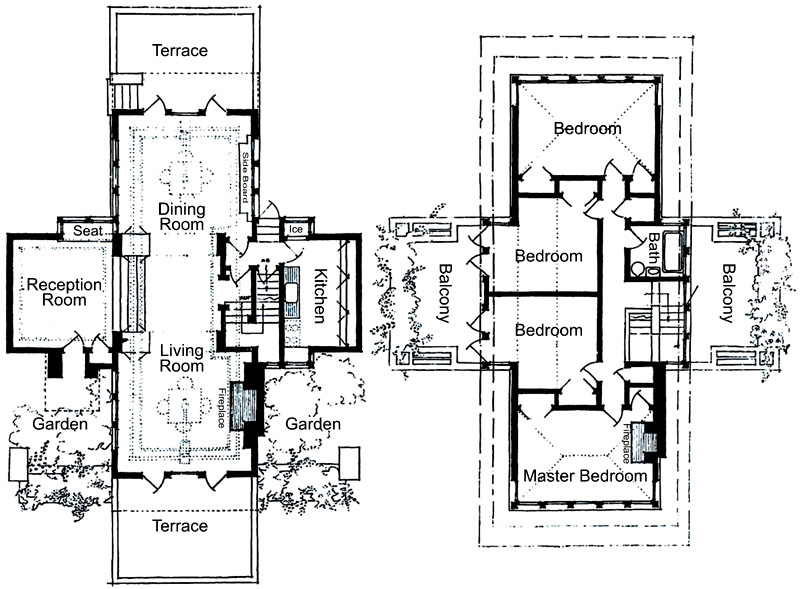 |
Floor plan for
the First level, 1911. As you walk through
the front door you enter the Reception Room. The
front door, although hidden behind a garden
wall, could be seen from the street (North).
Built-in oak cabinets and seating lined the
walls. Stairs lead up to the balance of the
first level. Built-in book cases are on either
side of the stairs. The Dining Room is on the
left, the Living Room is on the right. A
Sideboard is built-into the west wall of the
Dining Room, high art glass windows above it.
The large, prairie styled Fireplace is located
in the Living Room, covering most of the west
wall. Art glass doors lead out to a Terraces on
either end. The second floor overhangs the
Terrace, diminishing direct overhead sunlight.
Vertical spindled screens enclose the stairway
that leads to the second level and a doorway
that leads to the Kitchen.
Floor plan for the Second level. As you
reach the top of the stairs, turn right to the
exterior balcony over the Kitchen, with built-in
Planters. Bedrooms and the Bath were reached by
turning left at the top of the stairs. The
Balcony on the east is reached through the two
smaller Bedrooms. Courtesy of "Frank
Lloyd Wright, Ausgeführte Bauten"
(Executed Buildings), 1911.
Modified by Douglas M. Steiner,
copyright 2012. |
|
|
|
|
|
|
|
|
|
Horner Residence Circa 1910 |
|
|
|
|
When Wright published "Ausgeführte
Bauten und Entwürfe von Frank Lloyd Wright" in
1910, he
chose not to include the Horner Residence, but instead
included an illustration and floor plan of the Barton (Plate
XXVI), DeRhodes (Plate XXIX), and although not the same
floor plan, the Gale (Plate XLV).
One year later Wright did included an
exterior and interior photograph of the Horner Residence in "Frank
Lloyd Wright, |
|
Ausgeführte Bauten"
(Executed Buildings),
1911 pages 62. That same year Wright included the same
two photographs when he published
"Frank
Lloyd Wright,
Chicago" (Sonderheft),
1911, pages 54.
The two interiors were photographed by
Henry Fuermann. One of the exterior photographs is confirmed
as Fuermann's, and he most likely photographed the other. |
|
|
|
|
|
1) Front
Exterior 2) Back Exterior
3) Interior From Reception Room
4) Interior from Dining Room
5) Question about the Front Door
|
|
|
|
1) Front Exterior |
|
|
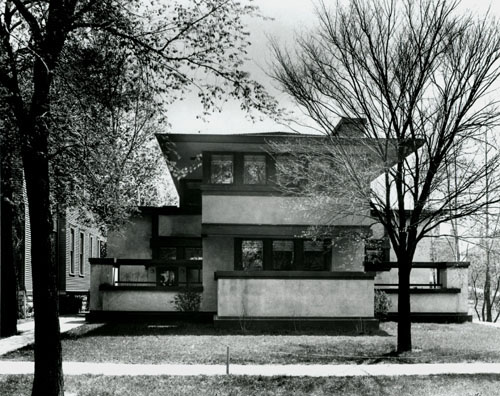 |
1A)
Front exterior viewed from the street, looking South. As
you entered the sidewalk on the left, you passed the Garden
Wall with it's pedestal that begged for a urn. A large
prairie styled Robie House urn would have fit perfectly.
Turning right into the Garden, you entered the home through
the art glass front door. The Reception Room is on the left.
Five wide stairs lead up to the balance of the first level.
The Living Room is in the center foreground with art glass
doors that exit out to an enclosed Terrace. The Stairway
landing and Kitchen overlooked the symmetrical Garden and
Garden Wall on the right.
Upper level. As you reached the top of the stairs,
the Bedrooms and the Bath were reached by turning left. The
Balcony on the east (left) was reached through the two
smaller Bedrooms in the center of the upper level. A row of
art glass windows were just beneath the roof line of the
Master Bedroom in the center. Turning right at the top of
the stairs lead to the exterior balcony over the Kitchen.
Both Balconies had built-in Planters on either end. The low
pitch of the roof almost gives the appearance of being flat
like the Gale Residence. Most likely photographed by
Henry Fuermann. |
| |
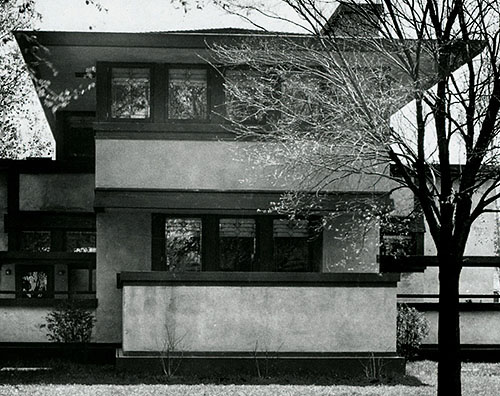 |
1B)
Lower level. The Reception Room is on the left. The
Living Room is in the center foreground with art glass doors
that exit out to an enclosed Terrace. The Stairway landing
and Kitchen overlook the symmetrical Garden and Garden Wall
on the right.
Second level. A row of art glass windows
were just beneath the roof line of the Master Bedroom in the
center. |
|
|
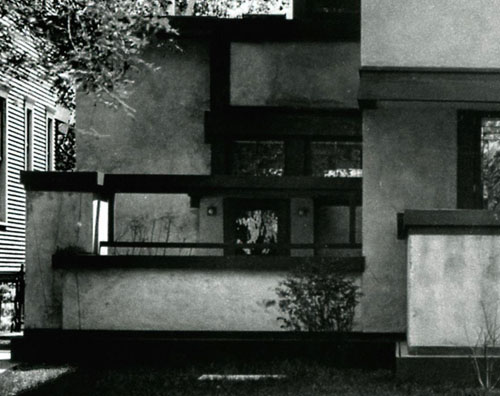 |
| 1C) As you
passed the Garden Wall with it's pedestal, it begged for a
large prairie styled urn. Turning right into the Garden, you
entered the home through the art glass front door. Two
clerestory art glass windows can be seen above and to the
right of the front door. On the opposite wall above the
built-in seating were two additional clerestory art glass
windows and two below them, adding to the symmetry to the Reception Room. Five
wide stairs lead up to the balance of the first level. The
Living Room and enclosed Terrace are to the right. |
| |
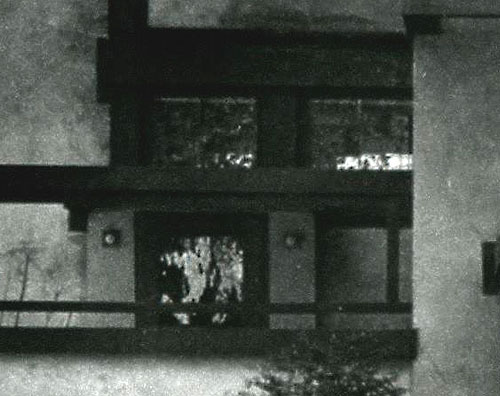 |
| 1D)
Entrance to the home was through an art glass front door
that was facing the street, but hidden behind the garden
Wall. Two clerestory art glass windows can be seen above and
to the right of the front door. On the opposite wall above
the built-in seating were two additional clerestory art
glass windows and two below them, adding to the symmetry to the Reception Room. |
| |
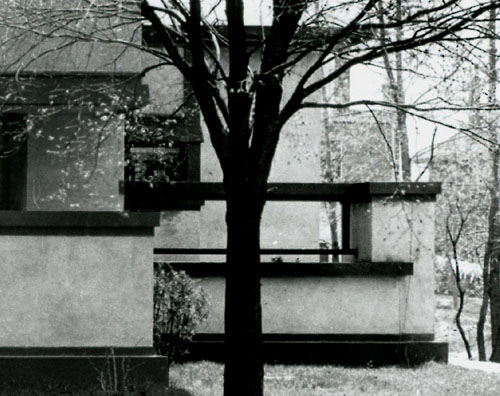 |
| 1E) The
Stairway landing and Kitchen overlooked the symmetrical
Garden and Garden Wall. |
| |
| |
| |
|
2) Back Exterior |
|
|
 |
2A)
Back exterior viewed from the back yard, looking North.
The Kitchen and back Entrance is on the left. The Dining
Room is in the center foreground with art glass doors that
exit out to the Terrace. On the right side stairs lead down
to the back yard. From the Living and Dining Room, five wide
stairs lead down to the Reception Room on the right. Note:
the house across the street seen on the left still exists.
Upper level. A door at the top of the stairs leads
out to the Balcony over the Kitchen on the left. Bedrooms
and the Bath are in the center, The
Balcony over the Kitchen on the east (right) was reached through the two
smaller Bedrooms in the center of the upper level. A row of
art glass windows were just beneath the roof line of the
large Bedroom in the center. Both Balconies had built-in Planters on either end. The low
pitch of the roof almost gives the appearance of being flat
like the Gale Residence. Most likely photographed by
Henry Fuermann. |
| |
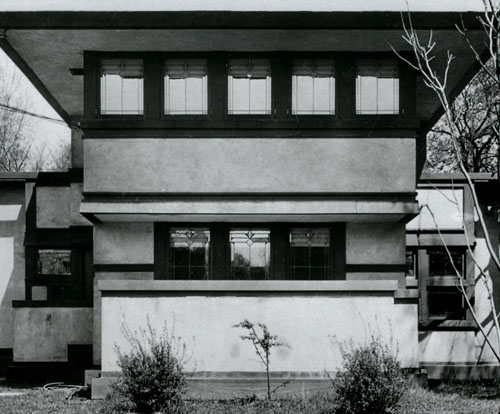 |
2B)
Lower level. The Kitchen and back Entrance was on the
left. The Dining Room was in the center foreground with art
glass doors that exit out to the Terrace. On the right side
stairs lead down to the back yard. From the Living and
Dining Room, five wide stairs lead down to the Reception
Room on the right.
Upper level. A row of
art glass windows were just beneath the roof line of the
large Bedroom in the center. |
|
|
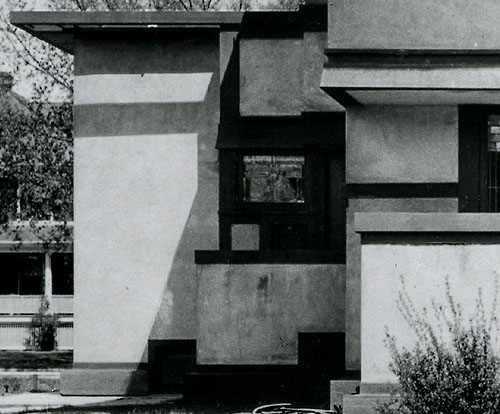 |
| 2C) The
Kitchen is on the left, the back Entrance is the center. An
art glass window was above the ice door. Stairs behind the
half wall lead up to the back door, just to the right of the
window, hidden from view. The Dining Room and Terrace was on
the right. |
| |
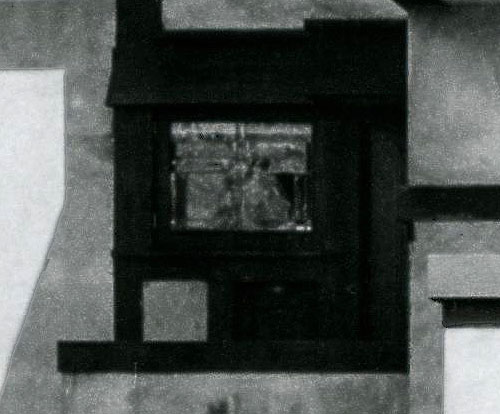 |
| 2D) Detail
of the back Entrance. An art glass window was above the ice
door. Stairs behind the half wall lead up to the back door,
just to the right of the window, hidden from view. |
| |
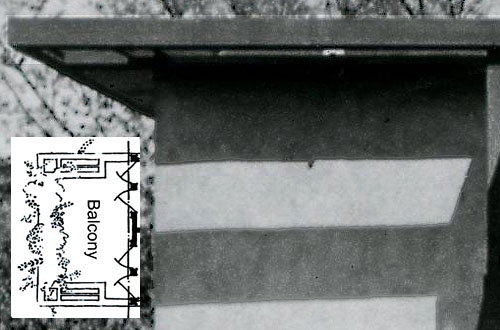 |
| 2E) Wright
designed a pattern into the balcony overhang, casting ever
changing shadows on the stucco walls. |
| |
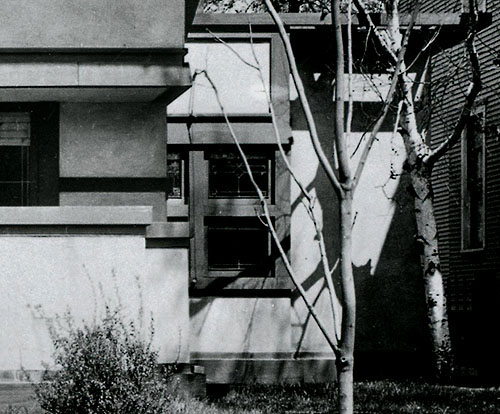 |
| 2F) The Dining
Room is on the left, stairs lead down to the back yard. From
the Living and Dining Room, five wide stairs lead down to
the Reception Room on the right. Two upper and two lower
windows are just above the built-in seating in the Reception
area. |
| |
|
|
|
|
|
3) Interior from the Reception Room |
|
|
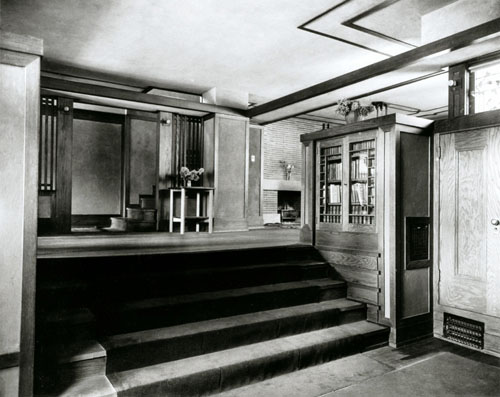 |
| 3A)
View of the Living Room from the Reception Room. As
you opened the art glass front door, you entered the Reception Room.
Wright chose wood and stucco for the exterior of the home.
Behind the camera to the left were built-in seats. Above the
coat closet and front door to the right, were a pair of
clerestory art glass windows. On either side of the five wide stairs
were built-in oak book cases, which opened up in the front
and back. At the top of the stairs the Dining Room was to
the left. Entering the hall straight ahead, enclosed by a
pair of vertical spindled screens, you could turn left to go
to the Kitchen, or take the stairs to the right to reach the
second level. The Living Room on the right. The large,
prairie styled Fireplace was located in the Living Room to
the right, covered most of the west wall. Photographed by
Henry Fuermann. |
| |
 |
| 3B)
Entering the hall enclosed by a pair of vertical spindled
screens, you could turn left to go to the Kitchen, or take
the stairs to the right to reach the second level. The
large, prairie styled Fireplace was located in the Living
Room to the right, and covered most of the west wall.
|
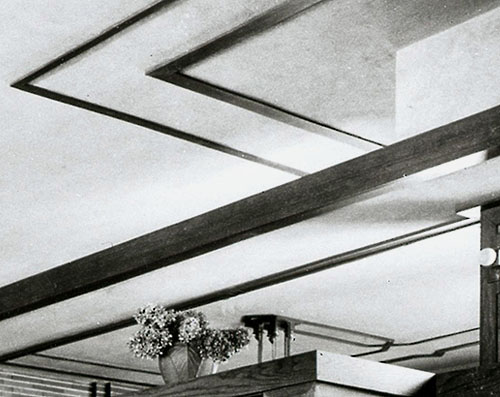 |
| 3C) Oak
Trim on the ceiling created a pattern throughout the first
floor and continued from room to room. |
|
|
|
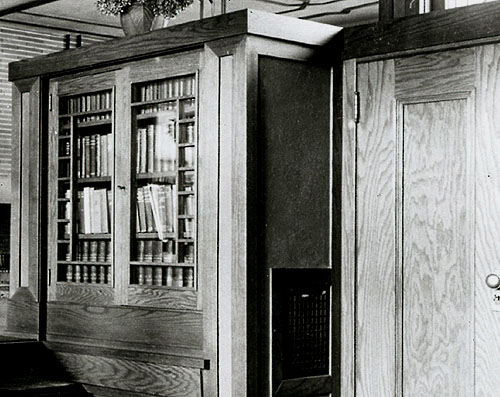 |
| 3D)
Built-in oak book cases, opened up in the front and back.
The coat closet was to the right. |
| |
|
. |
|
|
|
4) Interior from the Dining Room |
|
|
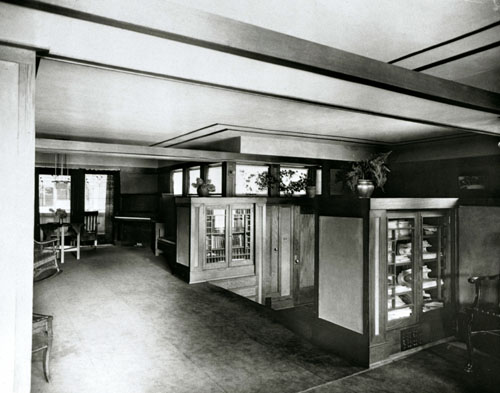 |
| 4A)
View of the Living Room from the Dining Room. Art glass
doors in the Living Room on the left, opened out to an
enclosed Terrace. The west (left) wall of the Living Room
was covered by the fireplace. The east (right) wall
of the Living Room included three "high windows" that fell
in line with the two in the Reception Room. On either side of the wide stairs
were built-in oak book cases, which opened up in the front
and back. Photographed by
Henry Fuermann. |
| |
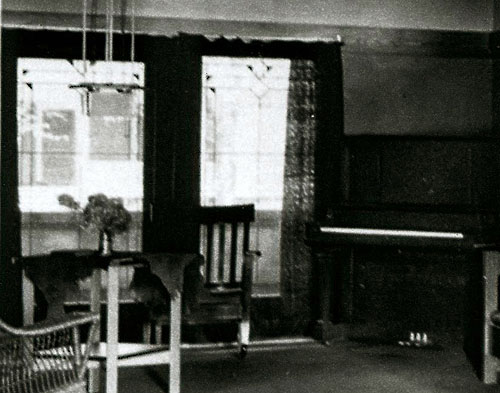 |
| 4B) Art glass
doors in the Living Room, opened out to an
enclosed Terrace. We get a glimpse of the art glass light
fixture most likely designed by Frank Lloyd Wright. Note the
piano in the right corner. |
| |
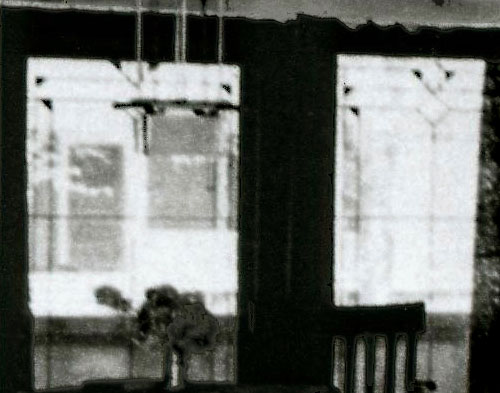 |
| 4C) Detail
of the Living Room light fixture most likely designed be
Frank Lloyd Wright. They are similar to the fixtures Wright
designed for the Browne's
Bookstore, during the same time period. |
| |
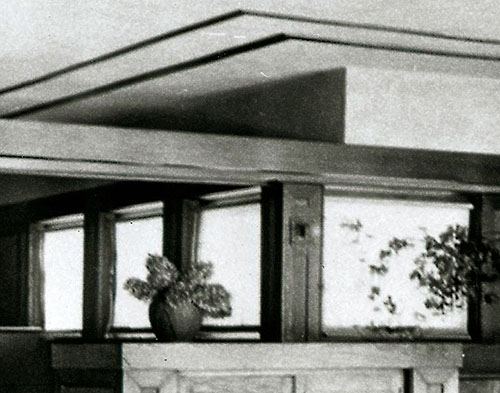 |
| 4D) Oak
Trim on the ceiling created a pattern throughout the first
floor and continued from room to room. The east wall of the
Living Room included three "high windows" that fell in line
with the two in the Reception Room. |
| |
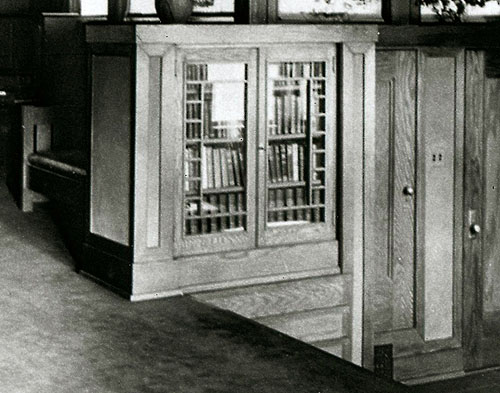 |
|
4E) Oak Book case on the
Living Room side of the wide stairs, which opened up in the
front and back. Note the Living Room bench to the left of
the book case. |
|
|
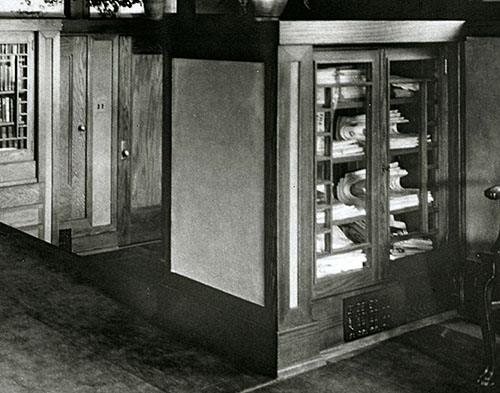 |
|
4F) Oak Book case on the
Dining Room side of the wide stairs, which opened up in the
front and back. |
|
|
|
|
|
. |
|
5) Question about the front door |
|
|
|
In image 1D below, the
exterior front door appears to be glass. But in the interior
image 4G below, the door to the right appears to be solid
oak. The floor plan Wright published in "Frank
Lloyd Wright, Ausgeführte Bauten"
(Executed Buildings), 1911,
after the home was completed. It
clearly shows a front door (left) and a closet door (right). |
|
|
 |
| 1D) The
exterior front door appears to be glass. |
| |
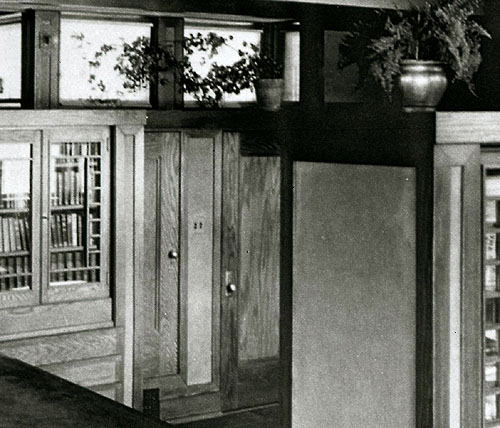 |
| 4G) The
door to the right appears to be solid oak. |
| |
 |
| Floor plan
Wright published in "Frank
Lloyd Wright, Ausgeführte Bauten"
(Executed Buildings), 1911,
after the home was completed.
This clearly shows a front door (left) and a closet door
(right). |
| |
| |
|
|
|
|
Horner Residence Circa 1915-1920 |
|
|
|
|
|
Photographed by Henry Fuermann
and published in
"In The Nature of Material", Hitchcock, 1942.
Hitchcock does not date this photograph but indicates in the
Acknowledgments that Fuermann photographs were from his
early work. Landscaping in front of the |
|
home has matured (3-5 years),
but is very similar. The lot on the right, which was vacant
in the 1910 photographs, has now been built. Courtesy of The
Art Institute of Chicago. |
|
|
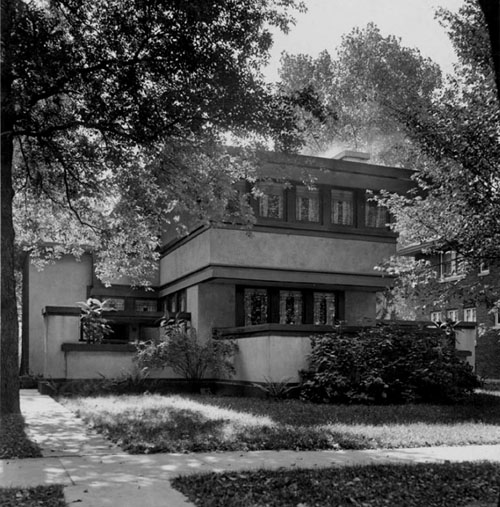 |
1A)
Front exterior viewed from the street, looking South. As
you entered the sidewalk on the left, you passed the Garden
Wall with it's pedestal that begged for a urn. A large
prairie styled Robie House urn would have fit perfectly.
Turning right into the Garden, you entered the home through
the front door. The Reception Room is on the left.
Five wide stairs lead up to the balance of the first level.
The Living Room is in the center foreground with art glass
doors that exit out to an enclosed Terrace. The symmetrical Garden Wall on the
far right.
Upper level. As you reached the top of the stairs,
the Bedrooms and the Bath were reached by turning left. The
Balcony on the east (left) above the Reception Room was reached through the two
smaller Bedrooms in the center of the upper level. A row of
art glass windows were just beneath the roof line of the
Master Bedroom in the center. The Balconies had built-in Planters on either end. The low
pitch of the roof almost gives the appearance of being flat
like the Gale Residence.
Photographed by
Henry Fuermann. Courtesy of The Art Institute of Chicago. |
| |
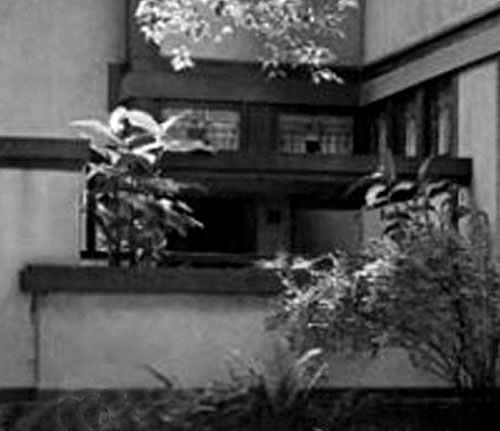 |
|
1B) Turning right
into the Garden, you entered the home through
the front door and step into the Reception Room.
Two art glass windows are directly above. Five wide stairs lead up to the balance of the first level.
The three windows on the right add light to the
Living Room. |
|
|
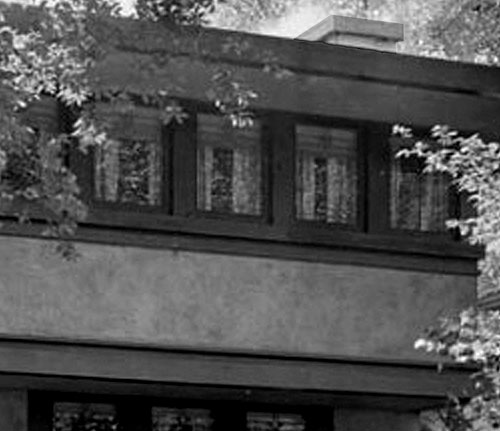 |
|
1C) A row of
art glass windows were just beneath the roof line of the
Master Bedroom. Five across the front, one on either side. |
|
|
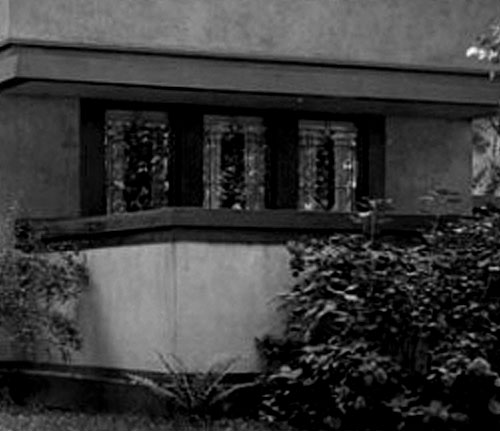 |
|
1D) From the
Living Room, art glass
doors exit out to an enclosed Terrace. |
|
|
|
|
|
|
|
|
|
Horner Residence Circa 1935 - 1940 |
|
|
|
|
|
Gilman Lane photographed
building in the Chicago area including many of Wright’s
work. Upon his death in 1961, Lane donated his collection of
over 700 photographs to the Oak Park Public Library. He left
an early record of over 150 Wright buildings. In the seminal
Biography of Wright's Work by
Henry-Russell Hitchcock, "The
Nature of Materials", Hitchcock credits Henry Fuermann
and |
|
Sons, and "another important
group of photographs taken by Gilman Lane... who has been
photographing Wright's work for many years..."
These three photographs are not dated but
most likely photographed during the late 1930s to early
1940s. The front Terrace was enclosed, and the landscaping
has matured. |
|
|
|
1) Exterior Viewed from the Northeast |
|
|
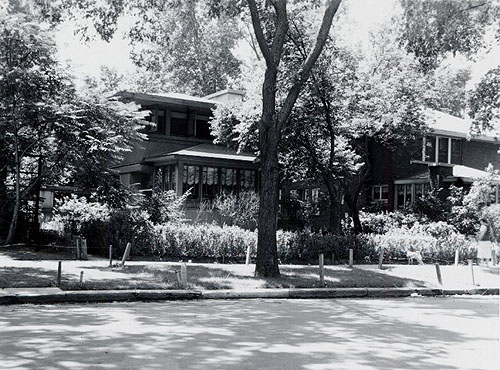 |
1A)
Front exterior viewed from the street, looking Southwest. As
you entered the sidewalk on the left side of the home, you passed the Garden
Wall.
Turning right into the Garden, you entered the home through
the front door into the Reception Room on the left.
Five wide stairs lead up to the balance of the first level.
The Living Room Terrace in the center foreground was enclosed
with a roof and windows.
Upper level. As you reached the top of the stairs,
the Bedrooms and the Bath were reached by turning left. A row of
art glass windows were just beneath the roof line of the
Master Bedroom in the center. Both Balconies had built-in Planters on either end. The low
pitch of the roof almost gives the appearance of being flat
like the Gale Residence.
Photographed by Gilman Lane. Courtesy of the Oak Park Public
Library. |
| |
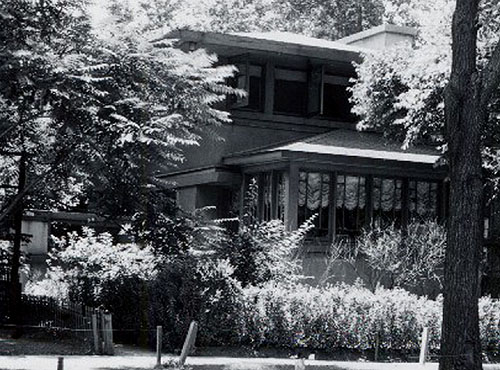 |
1B)
Front exterior viewed from the street, looking Southwest.
As you entered the sidewalk on the left side of the home,
you passed the Garden Wall. Turning right into the Garden,
you entered the home through the front door into the
Reception Room on the left. Five wide stairs lead up to the
balance of the first level. The Living Room Terrace was
enclosed with a roof and windows.
Upper level. As you reached the top of the stairs,
the Bedrooms and the Bath were reached by turning left. A
row of art glass windows that open outward were just beneath
the roof line of the Master Bedroom in the center. |
|
|
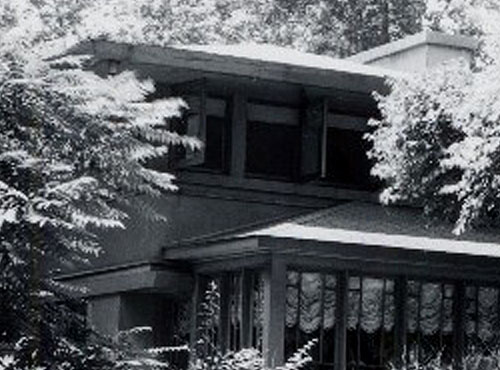 |
|
1C) Upper level. A row
of art glass windows that opened outward were just beneath
the roof line of the Master Bedroom. |
|
|
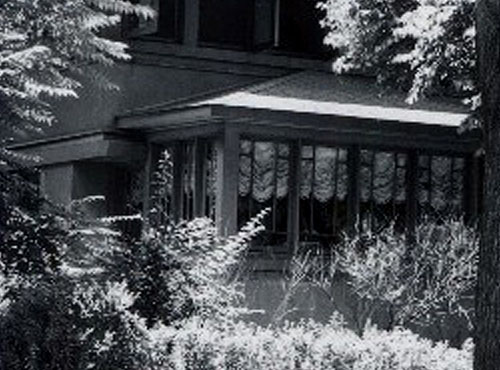 |
1D) The Living Room Terrace
was enclosed with a roof and windows.
Upper level. As you reached the top of the stairs,
the Bedrooms and the Bath were reached by turning left. A
row of art glass windows were just beneath the roof line of
the Master Bedroom in the center. Both Balconies had
built-in Planters on either end. |
|
|
|
|
|
|
|
2) Exterior Viewed from the North |
|
|
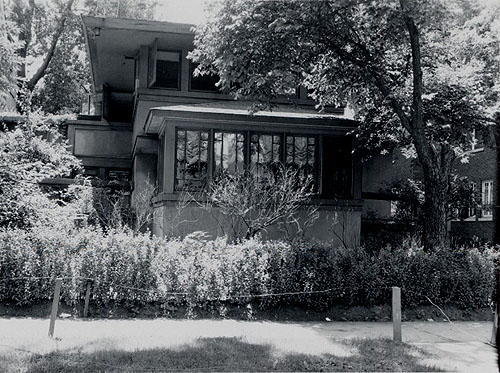 |
2A)
Front exterior viewed from the street, looking South. As
you entered the sidewalk on the left side of the home, you passed the Garden
Wall.
Turning right into the Garden, you entered the home through
the front door into the Reception Room on the left. Five
wide stairs lead up to the balance of the first level. The
Living Room Terrace in the center foreground was enclosed
with a roof and windows. The Stairway
landing and Kitchen overlooked the symmetrical Garden and
Garden Wall on the right.
Upper level. As you reached the top of the stairs,
the Bedrooms and the Bath were reached by turning left. The
Balcony on the east (left) was reached through the two
smaller Bedrooms in the center of the upper level. A row of
art glass windows were just beneath the roof line of the
Master Bedroom in the center. Turning right at the top of
the stairs lead to the exterior balcony over the Kitchen.
Both Balconies had built-in Planters on either end. The low
pitch of the roof almost gives the appearance of being flat
like the Gale Residence.
Photographed by Gilman Lane. Courtesy of the Oak Park Public
Library. |
| |
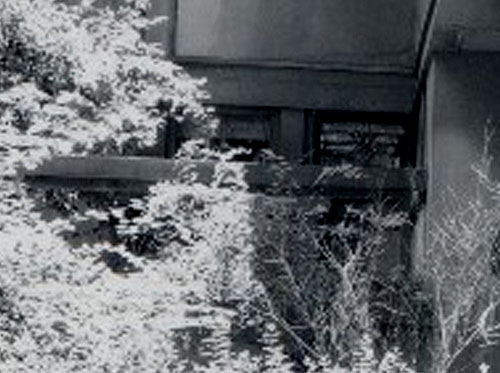 |
|
2B) Turning right into the
Garden, you entered the home through the front door and step
into the Reception Room. Two art glass windows are directly
above. Five wide stairs lead up to the balance of the first
level. |
|
|
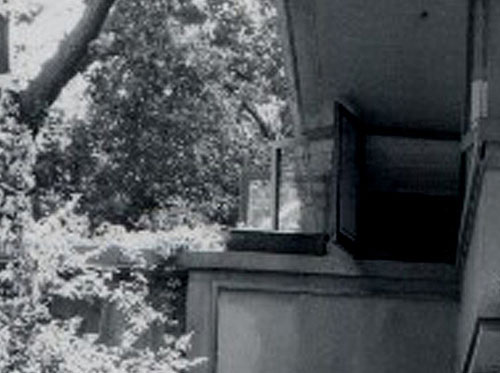 |
|
2C) Upper level. As
you reached the top of the stairs, the Bedrooms and the Bath
were reached by turning left. The Balcony on the east (left)
was reached through the two smaller Bedrooms in the center
of the upper level. Two doors can be seen to the left of the
open Bedroom window. Both Balconies had built-in Planters on
either end. |
|
|
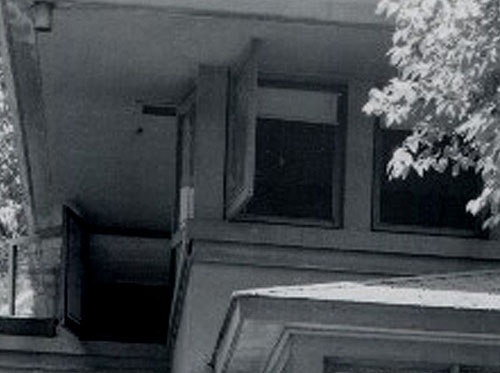 |
|
2D) Upper level. As
you reached the top of the stairs, the Bedrooms and the Bath
were reached by turning left. The Balcony on the east (left)
was reached through the two smaller Bedrooms in the center
of the upper level. A row of art glass windows were just
beneath the roof line of the Master Bedroom in the center. |
|
|
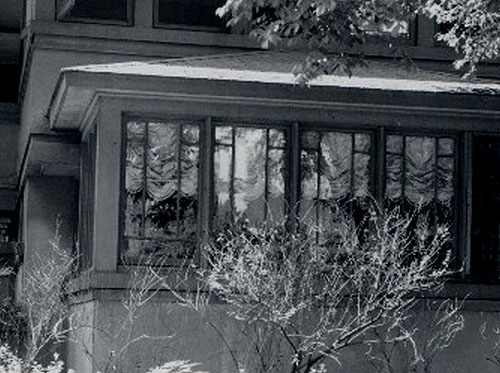 |
|
2E) The Living Room Terrace
in the center foreground was enclosed with a roof and
windows. |
|
|
|
|
|
|
|
3) Exterior Viewed from the Northwest |
|
|
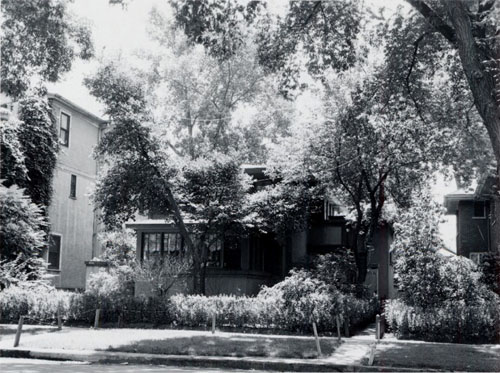 |
3A)
Front exterior viewed from the street, looking Southeast. As
you entered the sidewalk on the left side of the home, you passed the Garden
Wall.
Turning right into the Garden, you entered the home through
the front door into the Reception Room on the left. Five
wide stairs lead up to the balance of the first level. The
Living Room Terrace in the center foreground was enclosed
with a roof and windows. The Stairway
landing and Kitchen overlooked the symmetrical Garden and
Garden Wall on the right.
Upper level. As you reached the top of the stairs,
the Bedrooms and the Bath were reached by turning left. A row of
art glass windows were just beneath the roof line of the
Master Bedroom in the center. Turning right at the top of
the stairs lead to the exterior balcony over the Kitchen.
Both Balconies had built-in Planters on either end. The low
pitch of the roof almost gives the appearance of being flat
like the Gale Residence.
Photographed by Gilman Lane. Courtesy of the Oak Park Public
Library. |
| |
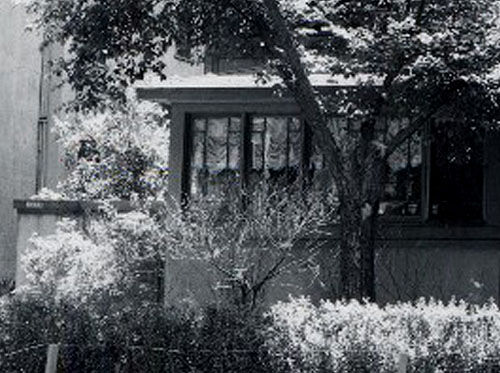 |
|
3B) As
you entered the sidewalk on the left side of the home, you passed the Garden
Wall.
Turning right into the Garden, you entered the home through
the front door into the Reception Room on the left. The
Living Room Terrace was enclosed
with a roof and windows. |
|
|
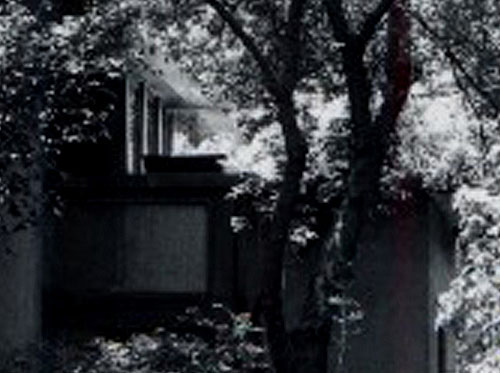 |
|
3C) Upper level. As
you reached the top of the stairs, the Bedrooms and the Bath
were reached by turning left. Turning right at the top of
the stairs lead to the exterior balcony over the Kitchen.
Both Balconies had built-in Planters on either end. |
|
|
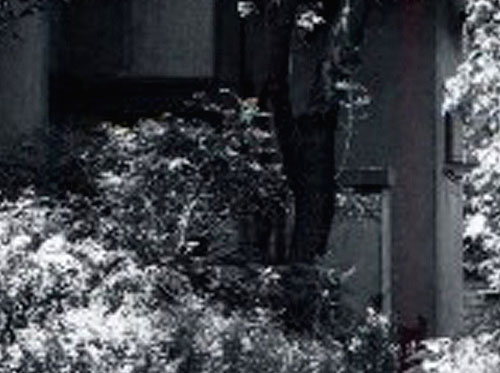 |
|
3D) The Stairway
landing and Kitchen overlooked the symmetrical Garden and
Garden Wall. The two Kitchen windows on the west wall can be
glimpsed of on the far right. They were included on Wright's
original drawings, but omitted from the drawings for "Frank
Lloyd Wright, Ausgeführte Bauten"
(Executed Buildings),
1911. |
|
|
Horner Art Glass Doors & Windows |
|
|
|
|
|
The Horner art glass doors and
windows were simple, geometric and symmetrical in design.
They were executed in clear glass with a small triangle in
color. There were three basic sizes; doors on the first and
second level, high windows on the first level and the
bedroom windows on the second level. All opened outward.
Besides the front and back doors, the Living and Dining
Rooms each had three doors that opened out to the front and
back terraces. Each of the small bedrooms upstairs had a
double set of doors that opened out to the balcony on the
east side, and the hall at the top of the stairs had a door
that opened out to the balcony on the west side. |
|
Wright labeled the smaller windows on the
first level "high windows". These aligned with the top of
the doors, allowed light into the rooms, but gave privacy
from the outside world. There were two above the front door
and three on the east side of the Living Room. They also
appeared in the kitchen, three above the sideboard in the
Dining Room, as well as three on the opposite wall of the
Dining Room.
The larger windows appeared in rows just
beneath the roof line of the second floor.
Illustrations adapted by Douglas M.
Steiner. |
|
|
|
|
|
|
|
|
|
|
Horner Property Today |
|
|
|
|
At the turn of the century,
Rogers Park was a northern community, considered "out in the
country". Today, it is hard to imagine passing farms as you
headed North from downtown Chicago. In 1900, the
Northwestern Elevated Railroad ended at Wilson Avenue, just
a few blocks West of Lincoln Park. Farms could still be seen
from the elevated platform.
To describe the city as exploding northward
could be considered an understatement. When the Horners
built their |
|
home in 1908, the population of
Rogers Park was under 10,000. When Mrs. Horner moved from
her home in 1925 the population of Rogers Park had past
50,000, making it one of the most densely populated areas in
Chicago. The city continued to grow, and just 44 years after
Wright designed the home, it too was consumed by growth.
Combined with a lack of appreciation for Wright's work, it was demolished to make room for a small
non-descript apartment building. |
| |
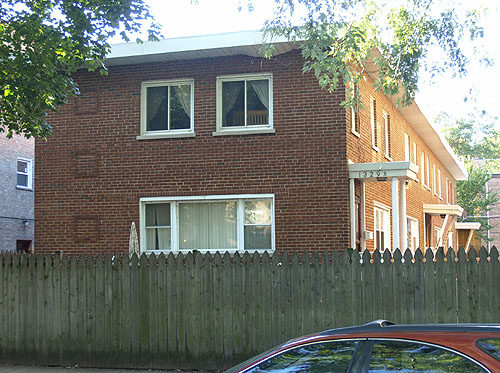 |
|
The Horner property today.
Courtesy of Cook County 2009. |
| |
|
|
|
|
|
BIBLIOGRAPHY |
|
|
|
"Music Trade Review",
May 18, 1910, page 91. |
|
"Frank
Lloyd Wright, Ausgeführte Bauten",
Wright, 1911, pages 62-63. |
| "Frank
Lloyd Wright,
Chicago" (Sonderheft),
Wright, 1911, pages 53-54. |
|
"The Lake Shore
News", October 31, 1912, page
15. |
|
"Music Trade Review",
April 6, 1918, page 34. |
|
"Music Trade Review",
June 29, 1918, page 37. |
|
"Music Trade Review",
July 13, 1918, page 31. |
|
"Printer's Ink",
November 18, page 130. |
|
"Music Trade Review",
July 18, 1925, page 30. |
|
"Music Trade Review",
January 1928, page 15. |
|
"In The Nature of Material",
Hitchcock, 1942, plate 136. |
|
"My Father Who is on Earth",
1946, Wright, page 77. |
| "The Frank Lloyd Wright Companion", Storrer,
1993, page 143. |
|
"Lost
Wright"
Lind, 1996, pages 39, 56-57. |
|
"Frank Lloyd Wright - Field Guide, Vol
2, MetroChicago",
Heinz, 1997, pages 113. |
|
"Frank Lloyd Wright,
Complete Works 1885-1916", Pfeiffer: Gossel, 2011,
pages 317. |
| |
|
|
|
|
|
|


























































